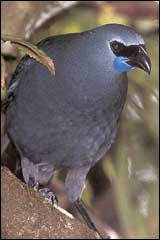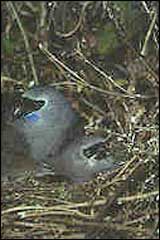|
|
|||
|
||||
|
Updated: September 6, 2001 |
|
|
|||||||||||||||||||||||||||||||||||||||||||||||||||||||||||||||||||||||||||||||||||||||||||||||||||||||||
 10 North Island kokako are living on Tiritiri Matangi |
|
 Harriers have been known to eat kokako eggs and chicks |
Kokako (Callaeas cinerea) are an endemic bird with steel-grey feathers belonging to the Wattlebird family.
North Island kokako have fleshy blue wattles on both sides of their necks. The subspecies in the South Island has orange coloured wattles. Early European settlers called the North Island birds, the Blue Wattled crow because of its inquisitiveness (very curious like a crow). Kokako used to be common through out the North Island but today fewer than 500 pairs exist.
Kokako are forest birds. They prefer mixed kauri/podocarp forest, although their habitat can include shrub lands. Kokako are poor fliers but have very strong legs to run and leap through the forest. Kokako only use their short rounded wings to glide from ridge tops to valley bottoms in short bursts. They can be seen gliding up to 100m.
The distinctive song of kokako - haunting and chime-like - is sung from the treetops at dawn. It is also used in defence of a territory of between 4 and 20 ha per pair of birds.
Kokako feed on a rich diversity of foods - fruits, leaves and insects. It adapts its diet as the food sources change through the seasons. Kokako like to eat fruit usually succulent berries. When these are not available they eat leaves and in summer they eat insects.
Like parrots, kokako feed by holding the fruit in one claw. The males are slightly larger but it is difficult to tell the sexes apart, with adults weighing around 230g. Kokako form territorial pairs and are together all year. Breeding is from October to March, generally producing 1 to 3 clutches in a season. The female builds a nest 2 - 32m above ground.
The South Island kokako may still exist in remote parts of the South Island and Stewart Island but no one is sure.
|
|
|
|
|
|
|
|
Slate - grey/blue Black "mask" over eyes Blue wattles (North Island) Orange wattles (South Island) |
Warmth |
|
|
|
Flying short distances Displays during mating |
|
|
|
Noisy when eating leaves |
Preening |
|
|
|
|
Holding food Bounding, running Hopping from branch to branch Chasing away other birds to defend territory |
|
|
|
18 days to hatch Nest well hidden 2 - 32m above ground |
|